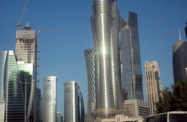Some of the heat seems to be going out of the Qatari economy, as the rate of expansion is expected to ease back to single figures over the next few years. However, the more modest growth forecast by analysts will still place the country among the global leaders.
Data issued by the Qatar Statistics Authority at the end of September showed that GDP expanded by 5% year-on–year (y-o-y) in the second quarter of 2012, down from the 6.9% growth recorded in the first quarter. Much of the activity in the second quarter was driven by the non-energy sector, with the communications sector’s contribution to GDP growing 18%, financial services posting a 12.1% rise and the construction industry – buoyed by the state’s increased investments in infrastructure – advancing by 10%. By contrast, the hydrocarbons sector expanded just 0.8% y-o-y in the second quarter of this year.
This easing is in line with projections from the IMF issued at the end of 2011, which stated that Qatar’s growth would slow to around 6% for this year, with the non-energy sector growing more quickly than the energy industry.
While far from the impressive 18.8% growth posted in 2011, this year’s estimated expansion is still expected to outperform most of Qatar’s major trading partners in Europe and Asia. A recent report issued by Saudi Arabia’s National Commercial Bank said the Qatari economy remained the star performer in the region, “although it is clear that the pace is moderating from the two-digit growth of recent years as the natural gas-liquefied-natural-gas investment pipeline in the country matures”.
This maturing refers to the hydrocarbons sector, the backbone of the national economy, which reached a plateau in 2011 when Qatar’s natural gas output reached the 77m-tonne export target set by the government, as the last of the new production facilities came on line. Output has increased steadily over the past decade, with growth of around 15% per year. Government officials have been attempting to find the optimum balance between the economy’s needs and managing the nation’s hydrocarbon reserves.
The government has since shifted its focus to other development programmes, including preparations for hosting the 2022 World Cup, as well as efforts to boost the transport, health, housing and industry sectors. According to Harish Bhatia, a consultant at the Hay Group, an international management firm, the state’s development programme would continue to fuel both growth and wage increases, with the latter needed to attract more professionals to the economy.
“Ambitious plans for infrastructure development, buoyed by the increasing presence of non-oil sectors, such as real estate, hospitality and manufacturing, are fuelling Qatar’s sustained demand for skilled talent,” Bhatia said in a statement accompanying a report on the Qatari economy, issued in early October.
The report said that wages were likely to increase by 6.5% in 2012 and by a further 5% in 2013. This is well above the current inflation rate, which is estimated to be between 2% and 3% this year, though well down on the 14% average wage increases witnessed in 2011, when skilled workers were at a premium.
Authorities will need to keep tabs on rising wage levels, monitoring whether this increased private spending power will prompt a surge in consumer demand, which could fuel the currently dormant inflation rate if supply side bottlenecks occur.
While a number of agencies, such as the central bank, would introduce counter measures if there was a return to the double-digit inflation witnessed late last decade, higher liquidity could spark a price break out. However, the central bank has a good deal of room to move if inflation were to increase, with its benchmark overnight deposit rate currently standing at just 0.75%, meaning it could tighten monetary supply when pressed to do so.
While there may be some slowing of demand for Qatari gas in the near term, this will only have a minimal impact on the economy, as the country will maintain its healthy current account surplus, despite the decline in hydrocarbon exports. With increased domestic spending set to underpin local growth, and boosted spending power for consumers, the economy should continue to tick along solidly.

